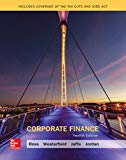
To answer: The given debate.
Introduction:
Modigliani-Miller theory:
Professors Modigliani and Miller made a research on capital structure theory very intensely. From the analysis, it is found that they formed a capital structure irrelevant proposal.
Debate:
There has been question raised and answer given for some questions regarding Modigliani-Miller Propositions. The questions are about equity increase, borrowing of debts and risk involved in the debts and equity. The final question raised was that, when a company uses equity or debt financing, and it is assumed that risk of both are raised by increasing in borrowing rate, so when there is a raise in the debt value and risk of the firm, will the company value decrease.
Want to see the full answer?
Check out a sample textbook solution
Chapter 16 Solutions
Loose Leaf for Corporate Finance Format: Loose-leaf
- Forest Enterprises, Incorporated, has been considering the purchase of a new manufacturing facility for $290,000. The facility is to be fully depreciated on a straight-line basis over seven years. It is expected to have no resale value after the seven years. Operating revenues from the facility are expected to be $125,000, in nominal terms, at the end of the first year. The revenues are expected to increase at the inflation rate of 2 percent. Production costs at the end of the first year will be $50,000, in nominal terms, and they are expected to increase at 3 percent per year. The real discount rate is 5 percent. The corporate tax rate is 25 percent. Calculate the NPV of the project. Note: Do not round intermediate calculations and round your answer to 2 decimal places, e.g., 32.16. NPVarrow_forwardHelp with questionsarrow_forwardPlease help with questionsarrow_forward
- Create financial forecasting years 2022, 2023, and 2024 using this balance sheet.arrow_forwardBeta Company Ltd issued 10% perpetual debt of Rs. 1,00,000. The company's tax rate is 50%. Determine the cost of capital (before tax as well as after tax) assuming the debt is issued at 10 percent premium. helparrow_forwardFinance subject qn solve.arrow_forward
